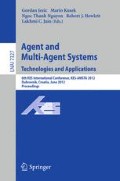Abstract
In complex application systems, there are typically not only autonomous components which can be represented by agents, but humans may also play a role. The interaction between agents and humans can be learned to enhance the stability of a system. How can agents adopt strategies of humans to solve conflict situations? In this paper, we present a learning algorithm for agents based on interactions with humans in conflict situations. The learning algorithm consists of four phases: 1) agents detect a conflict situation, 2) a conversation takes place between a human and agents, 3) agents involved in a conflict situation evaluate the strategy applied by the human, and 4) agents which have interacted with humans apply the best rated strategy in a similar conflict situation. We have evaluated this learning algorithm using a Jade/Repast simulation framework. An evaluation study shows two benefits of the learning algorithm. First, through interaction with humans, agents can handle conflict situations, and thus, the system becomes more stable. Second, agents adopt the problem solving strategy which has been applied most frequently by humans.
Access this chapter
Tax calculation will be finalised at checkout
Purchases are for personal use only
Preview
Unable to display preview. Download preview PDF.
References
Argall, B.D., Chernova, S., Veloso, M., Browning, B.: A Survey of Robot Learning From Demonstration. Robotics and Autonomous Systems 57(5), 469–483 (2009)
Görmer, J., Homoceanu, G., Mumme, C., Huhn, M., Müller, J.P.: JRep: Extending Repast Simphony for Jade Agent Behavior Components. In: Proceedings of the IEEE/WIC/ACM Int. Conf. on Intelligent Agent Technology, pp. 149–154 (2011)
Isbell, C., Kearns, M., Singh, S., Shelton, C., Stone, P., Kormann, D.: Cobot in LambdaMOO: A Social Statistics Agent. Autonomous Agents and Multiagent Systems 13(3), 327–354 (2006)
Knox, W.B., Stone, P.: Interactively Shaping Agents via Human Reinforcement - The TAMER Framework. In: Proceedings of the 15th International Conference on Knowledge Capture, pp. 9–16. ACM, New York (2009)
Knox, W.B., Stone, P.: Combining manual feedback with subsequent MDP reward signals for reinforcement learning. In: Proceedings of the 9th Int. Conference on Autonomous Agents and Multiagent Systems, vol. 1, pp. 5–12. AAMAS (2010)
Kuhlmann, G., Stone, P., Mooney, R.J., Shavlik, J.W.: Guiding a Reinforcement Learner With Natural Language Advice: Initial Results in RoboCup Soccer. In: Proceedings of the AAAI Workshop on Supervisory Control of Learning and Adaptive Systems (2004)
Le, N.T., Menzel, W., Pinkwart, N.: Considering Ill-definedness of Problems From The Aspect of Solution Space. In: Proceedings of the 23rd International Florida Artificial Intelligence Conference (FLAIRS), pp. 534–535. AAAI Press (2010)
Le, N.T., Märtin, L., Pinkwart, N.: Learning Capabilities of Agents in Social Systems. In: Proceedings of The 1st International Workshop on Issues and Challenges in Social Computing (WICSOC), held at the IEEE International Conference on Information Reuse and Integration (IRI), pp. 539–544. IEEE, NJ (2011)
Moreno, D.L., Regueiro, C.V., Iglesias, R., Barro, S.: Using Prior Knowledge to Improve Reinforcement Learning in Mobile Robotics. In: Proceedings of Towards Autonomous Robotic Systems (TAROS), Technical Report Series, Report Number CSM-415, Department of Computer Science, University of Essex (2004)
Ng, A.Y., Kim, H.J., Jordan, M.I., Sastry, S.: Inverted Autonomous Helicopter Flight Via Reinforcement Learning. In: International Symposium on Experimental Robotics. MIT Press (2004)
Panait, L., Luke, S.: Cooperative Multi-agent Learning: The State of the Art. Autonomous Agents and Multi-Agent Systems 11(3), 387–434 (2005)
Saggar, M., D’Silva, T., Kohl, N., Stone, P.: Autonomous Learning of Stable Quadruped Locomotion. In: Lakemeyer, G., Sklar, E., Sorrenti, D.G., Takahashi, T. (eds.) RoboCup 2006: Robot Soccer World Cup X. LNCS (LNAI), vol. 4434, pp. 98–109. Springer, Heidelberg (2007)
Schneider, J., Wong, W.K., Moore, A., Riedmiller, M.: Distributed Value Functions. In: Proceedings of the 16th International Conference on Machine Learning, pp. 371–378. Morgan Kaufmann (1999)
Sutton, R.S., Barto, A.G.: Reinforcement Learning: An Introduction. MIT Press (1998)
Taylor, M.E., Suay, H.B., Chernova, S.: Integrating Reinforcement Learning with Human Demonstrations of Varying Ability. In: Proceedings of the 10th Int. Conference on Autonomous Agents and Multiagent Systems, pp. 617–624. AAMAS (2011)
Thawonmas, R., Hirayama, J.-I., Takeda, F.: Learning from Human Decision-Making Behaviors - An Application to RoboCup Software Agents. In: Hendtlass, T., Ali, M. (eds.) IEA/AIE 2002. LNCS (LNAI), vol. 2358, pp. 136–145. Springer, Heidelberg (2002)
Weiß, G., Dillenbourg, P.: What is ’multi’ in Multi-agent Learning. In: Dillenbourg (ed.) Collaborative-learning: Cognitive, pp. 64–80. Pergamon Press, Oxford (1999)
Author information
Authors and Affiliations
Editor information
Editors and Affiliations
Rights and permissions
Copyright information
© 2012 Springer-Verlag Berlin Heidelberg
About this paper
Cite this paper
Le, NT., Pinkwart, N. (2012). Strategy-Based Learning through Communication with Humans. In: Jezic, G., Kusek, M., Nguyen, NT., Howlett, R.J., Jain, L.C. (eds) Agent and Multi-Agent Systems. Technologies and Applications. KES-AMSTA 2012. Lecture Notes in Computer Science(), vol 7327. Springer, Berlin, Heidelberg. https://doi.org/10.1007/978-3-642-30947-2_9
Download citation
DOI: https://doi.org/10.1007/978-3-642-30947-2_9
Publisher Name: Springer, Berlin, Heidelberg
Print ISBN: 978-3-642-30946-5
Online ISBN: 978-3-642-30947-2
eBook Packages: Computer ScienceComputer Science (R0)

